Nikon L840 vs Sony H300
The Nikon Coolpix L840 and the Sony Cyber-shot DSC-H300 are two digital cameras that were officially introduced, respectively, in February 2015 and February 2014. Both the L840 and the H300 are fixed lens compact cameras that are equipped with a 1/2.3-inch sensor. The Nikon has a resolution of 15.9 megapixels, whereas the Sony provides 19.9 MP.
Below is an overview of the main specs of the two cameras as a starting point for the comparison.

Check L840 offers at
ebay.com

Check H300 offers at
ebay.com
Going beyond this snapshot of core features and characteristics, what are the differences between the Nikon Coolpix L840 and the Sony Cyber-shot DSC-H300? Which one should you buy? Read on to find out how these two cameras compare with respect to their body size, their imaging sensors, their shooting features, their input-output connections, and their reception by expert reviewers.
Body comparison
The side-by-side display below illustrates the physical size and weight of the Nikon L840 and the Sony H300. The two cameras are presented according to their relative size. Three consecutive views from the front, the top, and the rear side are shown. All width, height and depth measures are rounded to the nearest millimeter.
The L840 can be obtained in two different colors (black, red), while the H300 is only available in black.
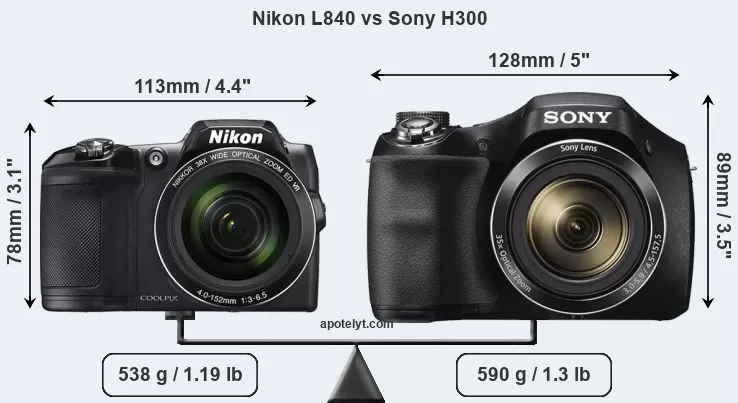
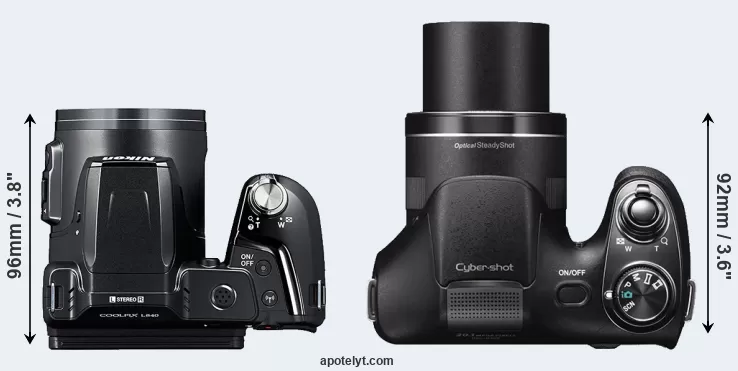
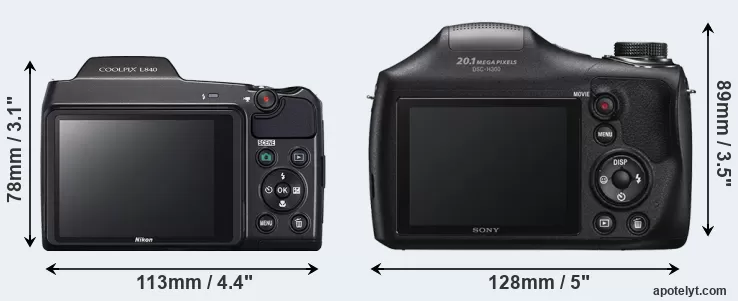
If the front view area (width x height) of the cameras is taken as an aggregate measure of their size, the Sony H300 is notably larger (29 percent) than the Nikon L840. Moreover, the H300 is markedly heavier (10 percent) than the L840. In this context, it is worth noting that neither the L840 nor the H300 are weather-sealed.
The table below summarizes the key physical specs of the two cameras alongside a broader set of comparators. In case you want to display and compare another camera duo, you can use the CAM-parator app to select your camera combination among a large number of options.

| # | Camera Model |
Camera Width |
Camera Height |
Camera Depth |
Camera Weight |
Battery Life |
Weather Sealing |
Camera Launch |
Launch Price (USD) |
Street Price |
|
|---|---|---|---|---|---|---|---|---|---|---|---|
| 1. | Nikon L840 | 113 mm | 78 mm | 96 mm | 538 g | 590 | n | Feb 2015 | 299 | ebay.com | |
| 2. | Sony H300 | 128 mm | 89 mm | 92 mm | 590 g | 350 | n | Feb 2014 | 219 | ebay.com | |
| 3. | Canon SX530 | 120 mm | 82 mm | 92 mm | 442 g | 210 | n | Jan 2015 | 429 | ebay.com | |
| 4. | Canon SX610 | 105 mm | 61 mm | 27 mm | 191 g | 270 | n | Jan 2015 | 249 | ebay.com | |
| 5. | Canon SX520 | 120 mm | 82 mm | 92 mm | 441 g | 210 | n | Jul 2014 | 399 | ebay.com | |
| 6. | Canon SX60 | 128 mm | 93 mm | 114 mm | 650 g | 340 | n | Sep 2014 | 549 | ebay.com | |
| 7. | Nikon B600 | 122 mm | 82 mm | 99 mm | 500 g | 280 | n | Jan 2019 | 349 | ebay.com | |
| 8. | Nikon B700 | 125 mm | 85 mm | 107 mm | 565 g | 350 | n | Feb 2016 | 499 | ebay.com | |
| 9. | Nikon B500 | 114 mm | 78 mm | 95 mm | 541 g | 600 | n | Jan 2016 | 299 | ebay.com | |
| 10. | Nikon P900 | 140 mm | 103 mm | 137 mm | 899 g | 360 | n | Mar 2015 | 599 | ebay.com | |
| 11. | Sony HX80 | 102 mm | 58 mm | 36 mm | 245 g | 390 | n | Mar 2016 | 349 | ebay.com | |
| 12. | Sony HX90V | 102 mm | 58 mm | 36 mm | 245 g | 360 | n | Apr 2015 | 429 | ebay.com | |
| 13. | Sony HX400V | 130 mm | 93 mm | 103 mm | 660 g | 300 | n | Feb 2014 | 499 | ebay.com | |
| 14. | Sony H400 | 130 mm | 95 mm | 122 mm | 628 g | 300 | n | Feb 2014 | 319 | ebay.com | |
| 15. | Sony H200 | 123 mm | 83 mm | 87 mm | 530 g | 240 | n | Jan 2013 | 249 | ebay.com | |
| Note: Measurements and pricing do not include easily detachable parts, such as add-on or interchangeable lenses or optional viewfinders. | |||||||||||
The price is, of course, an important factor in any camera decision. The manufacturer’s suggested retail prices give an idea on the placement of the camera in the maker’s lineup and the broader market. The H300 was launched at a markedly lower price (by 27 percent) than the L840, which puts it into a different market segment. Usually, retail prices stay at first close to the launch price, but after several months, discounts become available. Later in the product cycle and, in particular, when the replacement model is about to appear, further discounting and stock clearance sales often push the camera price considerably down.
Sensor comparison
The imaging sensor is at the core of digital cameras and its size is one of the main determining factors of image quality. All other things equal, a large sensor will have larger individual pixel-units that offer better low-light sensitivity, wider dynamic range, and richer color-depth than smaller pixels in a sensor of the same technological generation. Further, a large sensor camera will give the photographer additional creative options when using shallow depth-of-field to isolate a subject from its background. On the downside, larger sensors are more costly to manufacture and tend to lead to bigger and heavier cameras and lenses.
Both cameras under consideration feature a 1/2.3-inch sensor and have a format factor (sometimes also referred to as "crop factor") of 5.6. Within the spectrum of camera sensors, this places the review cameras among the smaller-sensor digicams that favor affordability and compact design. Both cameras feature a native aspect ratio (sensor width to sensor height) of 4:3.
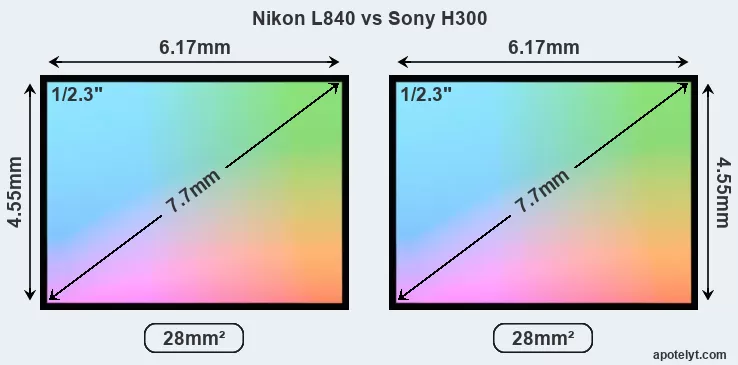
While the two cameras under review share the same sensor size, the H300 offers a higher resolution of 19.9 megapixels, compared with 15.9 MP of the L840. This megapixels advantage translates into a 12 percent gain in linear resolution. On the other hand, these sensor specs imply that the H300 has a higher pixel density and a smaller size of the individual pixel (with a pixel pitch of 1.19μm versus 1.33μm for the L840). Moreover, it should be noted, that the L840 is a somewhat more recent model (by 11 months) than the H300, and its sensor might have benefitted from technological advances during this time that further enhance the light gathering capacity of individual pixels. Coming back to sensor resolution, it should be mentioned that neither of the two cameras has an anti-alias filter installed, so they are able to capture all the detail the sensor resolves.
The resolution advantage of the Sony H300 implies greater flexibility for cropping images or the possibility to print larger pictures. The maximum print size of the H300 for good quality output (200 dots per inch) amounts to 25.8 x 19.3 inches or 65.4 x 49.1 cm, for very good quality (250 dpi) 20.6 x 15.5 inches or 52.3 x 39.3 cm, and for excellent quality (300 dpi) 17.2 x 12.9 inches or 43.6 x 32.7 cm. The corresponding values for the Nikon L840 are 23 x 17.3 inches or 58.5 x 43.9 cm for good quality, 18.4 x 13.8 inches or 46.8 x 35.1 cm for very good quality, and 15.4 x 11.5 inches or 39 x 29.3 cm for excellent quality prints.
The Nikon Coolpix L840 has a native sensitivity range from ISO 100 to ISO 6400. The corresponding ISO settings for the Sony Cyber-shot DSC-H300 are ISO 80 to ISO 3200 (no boost).
In terms of underlying technology, the L840 is build around a CMOS sensor, while the H300 uses a CCD imager. Both cameras use a Bayer filter for capturing RGB colors on a square grid of photosensors. This arrangement is found in most digital cameras.
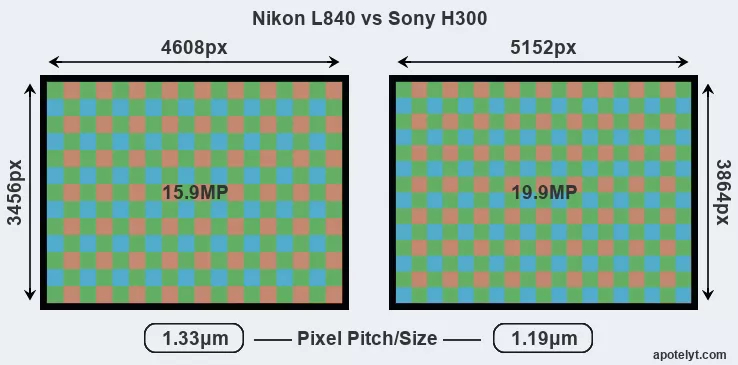
Since 2007, DXO Mark has published sensor performance measurements that have been derived using a consistent methodology. This service assesses and scores the color depth ("DXO Portrait"), dynamic range ("DXO Landscape"), and low-light sensitivity ("DXO Sports") of camera sensors, and also publishes an overall camera score. The following table provides an overview of the physical sensor characteristics, as well as the sensor quality measurements for a selection of comparators.

| # | Camera Model |
Sensor Class |
Resolution (MP) |
Horiz. Pixels |
Vert. Pixels |
Video Format |
DXO Portrait |
DXO Landscape |
DXO Sports |
DXO Overall |
|
|---|---|---|---|---|---|---|---|---|---|---|---|
| 1. | Nikon L840 | 1/2.3 | 15.9 | 4608 | 3456 | 1080/60i | 20.2 | 11.6 | 721 | 47 | |
| 2. | Sony H300 | 1/2.3 | 19.9 | 5152 | 3864 | 720/30p | 20.1 | 11.4 | 630 | 45 | |
| 3. | Canon SX530 | 1/2.3 | 15.9 | 4608 | 3456 | 1080/30p | 20.2 | 11.6 | 712 | 47 | |
| 4. | Canon SX610 | 1/2.3 | 20.2 | 5184 | 3888 | 1080/30p | 20.2 | 11.6 | 712 | 47 | |
| 5. | Canon SX520 | 1/2.3 | 15.9 | 4608 | 3456 | 1080/30p | 20.1 | 11.5 | 672 | 46 | |
| 6. | Canon SX60 | 1/2.3 | 14.2 | 4608 | 3072 | 1080/60p | 19.2 | 10.8 | 127 | 39 | |
| 7. | Nikon B600 | 1/2.3 | 15.9 | 4608 | 3456 | 1080/30p | 20.7 | 12.2 | 1095 | 52 | |
| 8. | Nikon B700 | 1/2.3 | 20.2 | 5184 | 3888 | 4K/30p | 20.4 | 11.8 | 818 | 48 | |
| 9. | Nikon B500 | 1/2.3 | 15.9 | 4608 | 3456 | 1080/60i | 20.3 | 11.7 | 810 | 48 | |
| 10. | Nikon P900 | 1/2.3 | 15.9 | 4608 | 3456 | 1080/60p | 20.2 | 11.6 | 727 | 47 | |
| 11. | Sony HX80 | 1/2.3 | 18.0 | 4896 | 3672 | 1080/60p | 20.4 | 11.8 | 822 | 48 | |
| 12. | Sony HX90V | 1/2.3 | 18.0 | 4896 | 3672 | 1080/60p | 20.2 | 11.6 | 738 | 47 | |
| 13. | Sony HX400V | 1/2.3 | 20.2 | 5184 | 3888 | 1080/60p | 20.1 | 11.4 | 629 | 45 | |
| 14. | Sony H400 | 1/2.3 | 19.9 | 5152 | 3864 | 720/30p | 20.1 | 11.4 | 630 | 45 | |
| 15. | Sony H200 | 1/2.3 | 15.2 | 5184 | 2930 | 720/30p | 19.9 | 11.2 | 529 | 44 | |
| Note: DXO values in italics represent estimates based on sensor size and age. | |||||||||||
Many modern cameras cannot only take still pictures, but also record videos. The two cameras under consideration both have sensors whose read-out speed is fast enough to capture moving pictures, but the L840 provides a higher video resolution than the H300. It can shoot video footage at 1080/60i, while the Sony is limited to 720/30p.
Feature comparison
Apart from body and sensor, cameras can and do differ across a variety of features. The L840 and the H300 are similar in the sense that neither of the two has a viewfinder. The images are, thus, framed using live view on the rear LCD. The following table reports on some other key feature differences and similarities of the Nikon L840, the Sony H300, and comparable cameras.

| # | Camera Model |
Viewfinder (Type or 000 dots) |
Control Panel (yes/no) |
LCD Specifications (inch/000 dots) |
LCD Attach- ment |
Touch Screen (yes/no) |
Max Shutter Speed * |
Max Shutter Flaps * |
Built-in Flash (yes/no) |
Built-in Image Stab |
|
|---|---|---|---|---|---|---|---|---|---|---|---|
| 1. | Nikon L840 | none | n | 3.0 / 921 | tilting | n | 1/4000s | 7.4/s | Y | Y | |
| 2. | Sony H300 | none | n | 3.0 / 460 | fixed | n | 1/1500s | 0.8/s | Y | Y | |
| 3. | Canon SX530 | none | n | 3.0 / 461 | fixed | n | 1/2000s | 1.6/s | Y | Y | |
| 4. | Canon SX610 | none | n | 3.0 / 922 | fixed | n | 1/2000s | 2.5/s | Y | Y | |
| 5. | Canon SX520 | none | n | 3.0 / 461 | fixed | n | 1/2000s | 1.6/s | Y | Y | |
| 6. | Canon SX60 | 922 | n | 3.0 / 922 | swivel | n | 1/2000s | 6.4/s | Y | Y | |
| 7. | Nikon B600 | none | n | 3.0 / 921 | fixed | n | 1/4000s | 7.4/s | Y | Y | |
| 8. | Nikon B700 | 921 | n | 3.0 / 921 | swivel | n | 1/4000s | 5.0/s | Y | Y | |
| 9. | Nikon B500 | none | n | 3.0 / 921 | tilting | n | 1/4000s | 7.4/s | Y | Y | |
| 10. | Nikon P900 | 921 | n | 3.0 / 921 | swivel | n | 1/4000s | 7.0/s | Y | Y | |
| 11. | Sony HX80 | 638 | n | 3.0 / 922 | tilting | n | 1/2000s | 10.0/s | Y | Y | |
| 12. | Sony HX90V | 638 | n | 3.0 / 921 | tilting | n | 1/2000s | 10.0/s | Y | Y | |
| 13. | Sony HX400V | 210 | n | 3.0 / 921 | tilting | n | 1/4000s | 10.0/s | Y | Y | |
| 14. | Sony H400 | 210 | n | 3.0 / 460 | fixed | n | 1/2000s | 0.7/s | Y | Y | |
| 15. | Sony H200 | none | n | 3.0 / 460 | fixed | n | 1/1500s | 0.8/s | Y | Y | |
| Note: *) Information refers to the mechanical shutter, unless the camera only has an electronic one. | |||||||||||
Both the L840 and the H300 have zoom lenses built in. The L840 has a 22.5-855mm f/3.0-6.5 optic and the H300 offers a 25-875mm f/3.4-6.5 (focal lengths in full frame equivalent terms). Hence, the Nikon provides a wider angle of view at the short end than the Sony, but less tele-photo reach at the long end. The L840 offers the faster maximum aperture.
The L840 writes its imaging data to SDXC cards, while the H300 uses SDXC or Memory Stick PRO Duo cards.
Connectivity comparison
For some imaging applications, the extent to which a camera can communicate with its environment can be an important aspect in the camera decision process. The table below provides an overview of the connectivity of the Nikon Coolpix L840 and Sony Cyber-shot DSC-H300 and, in particular, the interfaces the cameras (and selected comparators) provide for accessory control and data transfer.

| # | Camera Model |
Hotshoe Port |
Internal Mic / Speaker |
Microphone Port |
Headphone Port |
HDMI Port |
USB Port |
WiFi Support |
NFC Support |
Bluetooth Support |
|
|---|---|---|---|---|---|---|---|---|---|---|---|
| 1. | Nikon L840 | - | stereo / mono | - | - | micro | 2.0 | Y | Y | - | |
| 2. | Sony H300 | - | mono / mono | - | - | micro | 2.0 | Y | - | - | |
| 3. | Canon SX530 | - | stereo / mono | - | - | mini | 2.0 | Y | Y | - | |
| 4. | Canon SX610 | - | - / - | - | - | micro | 2.0 | Y | Y | - | |
| 5. | Canon SX520 | - | stereo / mono | - | - | mini | 2.0 | - | - | - | |
| 6. | Canon SX60 | Y | stereo / mono | Y | - | mini | 2.0 | Y | Y | - | |
| 7. | Nikon B600 | - | stereo / mono | - | - | micro | 2.0 | Y | - | Y | |
| 8. | Nikon B700 | - | stereo / mono | - | - | micro | 2.0 | Y | Y | Y | |
| 9. | Nikon B500 | - | stereo / mono | - | - | micro | 2.0 | Y | Y | Y | |
| 10. | Nikon P900 | - | stereo / mono | - | - | micro | 2.0 | Y | Y | - | |
| 11. | Sony HX80 | - | stereo / mono | - | - | micro | 2.0 | Y | Y | - | |
| 12. | Sony HX90V | - | stereo / mono | - | - | micro | 2.0 | Y | Y | - | |
| 13. | Sony HX400V | Y | stereo / mono | - | - | micro | 2.0 | Y | Y | - | |
| 14. | Sony H400 | - | mono / mono | - | - | micro | 2.0 | Y | - | - | |
| 15. | Sony H200 | - | mono / mono | - | - | - | 2.0 | - | - | - |
Both the L840 and the H300 have been discontinued, but can regularly be found used on ebay. The L840 was replaced by the Nikon B500, while the H300 does not have a direct successor. Further information on the features and operation of the L840 and H300 can be found, respectively, in the Nikon L840 Manual (free pdf) or the online Sony H300 Manual.
Review summary
So what conclusions can be drawn? Which of the two cameras – the Nikon L840 or the Sony H300 – has the upper hand? Is one clearly better than the other? A synthesis of the relative strong points of each of the models is listed below.

Arguments in favor of the Nikon Coolpix L840:
- Better video: Provides higher definition movie capture (1080/60i vs 720/30p).
- More detailed LCD: Has a higher resolution rear screen (921k vs 460k dots).
- More flexible LCD: Has a tilting screen for odd-angle shots in landscape orientation.
- Faster shutter: Has higher mechanical shutter speed (1/4000s vs 1/1500s) to freeze action.
- Faster burst: Shoots at higher frequency (7.4 vs 0.8 flaps/sec) to capture the decisive moment.
- Better light gathering: Has a lens with a wider maximum aperture (f/3.0 vs f/3.4).
- Wider view: Has a wider-angle lens that facilitates landscape or interior shots.
- More compact: Is smaller (113x78mm vs 128x89mm) and thus needs less room in the bag.
- Longer lasting: Can take more shots (590 versus 350) on a single battery charge.
- Easier device pairing: Supports NFC for fast wireless image transfer over short distances.
- More modern: Is somewhat more recent (announced 11 months after the H300).

Reasons to prefer the Sony Cyber-shot DSC-H300:
- More detail: Has more megapixels (19.9 vs 15.9MP), which boosts linear resolution by 12%.
- More tele-reach: Has a longer tele-lens for perspective compression and subject magnification.
- More affordable: Was introduced into a lower priced category (27 percent cheaper at launch).
- More heavily discounted: Has been on the market for longer (launched in February 2014).
If the count of individual advantages (bullet points above) is taken as a guide, the L840 is the clear winner of the match-up (11 : 4 points). However, the relative importance of the various individual camera aspects will vary according to personal preferences and needs, so that you might like to apply corresponding weights to the particular features before making a decision on a new camera. A professional wedding photographer will view the differences between cameras in a way that diverges from the perspective of a travel photog, and a person interested in cityscapes has distinct needs from a macro shooter. Hence, the decision which camera is best and worth buying is often a very personal one.
How about other alternatives? Do the specifications of the Nikon L840 and the Sony H300 place the cameras among the top in their class? Find out in the latest Best Superzoom Camera listing whether the two cameras rank among the cream of the crop.
In any case, while the comparison of technical specifications can provide a useful overview of the capabilities of different cameras, it remains incomplete and does no justice, for example, to the way the L840 or the H300 perform in practice. At times, user reviews, such as those published at amazon, address these issues in a useful manner, but such feedback is on many occasions incomplete, inconsistent, and unreliable.
Expert reviews
This is why expert reviews are important. The table below provides a synthesis of the camera assessments of some of the best known photo-gear review sites (amateurphotographer [AP], cameralabs [CL], digitalcameraworld [DCW], dpreview [DPR], ephotozine [EPZ], photographyblog [PB]). As can be seen, the professional reviewers agree in many cases on the quality of different cameras, but sometimes their assessments diverge, reinforcing the earlier point that a camera decision is often a very personal choice.

| # | Camera Model |
AP score |
CL score |
DCW score |
DPR score |
EPZ score |
PB score |
Camera Launch |
Launch Price (USD) |
Street Price |
|
|---|---|---|---|---|---|---|---|---|---|---|---|
| 1. | Nikon L840 | .. | + + | .. | .. | 3.5/5 | 4/5 | Feb 2015 | 299 | ebay.com | |
| 2. | Sony H300 | .. | + | .. | .. | 4.5/5 | 4/5 | Feb 2014 | 219 | ebay.com | |
| 3. | Canon SX530 | .. | + + | .. | .. | 4/5 | 4/5 | Jan 2015 | 429 | ebay.com | |
| 4. | Canon SX610 | .. | .. | .. | .. | 4/5 | 4/5 | Jan 2015 | 249 | ebay.com | |
| 5. | Canon SX520 | .. | + | .. | .. | 3.5/5 | 3.5/5 | Jul 2014 | 399 | ebay.com | |
| 6. | Canon SX60 | 3/5 | + + | .. | 75/100 | 4/5 | 4.5/5 | Sep 2014 | 549 | ebay.com | |
| 7. | Nikon B600 | .. | + | .. | .. | 3.5/5 | 3/5 | Jan 2019 | 349 | ebay.com | |
| 8. | Nikon B700 | .. | + | .. | .. | 4/5 | 4/5 | Feb 2016 | 499 | ebay.com | |
| 9. | Nikon B500 | .. | + | .. | .. | 4/5 | 3.5/5 | Jan 2016 | 299 | ebay.com | |
| 10. | Nikon P900 | .. | .. | .. | 77/100 | 4/5 | 4/5 | Mar 2015 | 599 | ebay.com | |
| 11. | Sony HX80 | .. | .. | .. | .. | .. | .. | Mar 2016 | 349 | ebay.com | |
| 12. | Sony HX90V | 4/5 | + + | .. | .. | 4/5 | 4.5/5 | Apr 2015 | 429 | ebay.com | |
| 13. | Sony HX400V | 4/5 | + + | .. | .. | 4/5 | 4/5 | Feb 2014 | 499 | ebay.com | |
| 14. | Sony H400 | .. | o | .. | .. | 3.5/5 | 3.5/5 | Feb 2014 | 319 | ebay.com | |
| 15. | Sony H200 | .. | .. | .. | .. | 3.5/5 | 3.5/5 | Jan 2013 | 249 | ebay.com | |
| Note: (+ +) highly recommended; (+) recommended; (o) reviewed; (..) not available. | |||||||||||
The review scores listed above should be treated with care, though. The assessments were made in relation to similar cameras of the same technological generation. Hence, a score should always be seen in the context of the camera's market launch date and its price, and comparing ratings of very distinct cameras or ones that are far apart in terms of their release date have little meaning. Also, please note that some of the review sites have changed their methodology and reporting over time.

Check L840 offers at
ebay.com

Check H300 offers at
ebay.com
Other camera comparisons
Did this review help to inform your camera decision process? If you would like to see a different side-by-side camera review, just use the search menu below. There is also a set of direct links to comparison reviews that other users of the CAM-parator app explored.
Specifications: Nikon L840 vs Sony H300
Below is a side-by-side comparison of the specs of the two cameras to facilitate a quick review of their differences and common features.
| Camera Model | Nikon L840 | Sony H300 |
|---|---|---|
| Camera Type | Fixed lens compact camera | Fixed lens compact camera |
| Camera Lens | 22.5-855mm f/3.0-6.5 | 25-875mm f/3.4-6.5 |
| Launch Date | February 2015 | February 2014 |
| Launch Price | USD 299 | USD 219 |
| Sensor Specs | Nikon L840 | Sony H300 |
| Sensor Technology | CMOS | CCD |
| Sensor Format | 1/2.3" Sensor | 1/2.3" Sensor |
| Sensor Size | 6.17 x 4.55 mm | 6.17 x 4.55 mm |
| Sensor Area | 28.0735 mm2 | 28.0735 mm2 |
| Sensor Diagonal | 7.7 mm | 7.7 mm |
| Crop Factor | 5.6x | 5.6x |
| Sensor Resolution | 15.9 Megapixels | 19.9 Megapixels |
| Image Resolution | 4608 x 3456 pixels | 5152 x 3864 pixels |
| Pixel Pitch | 1.33 μm | 1.19 μm |
| Pixel Density | 56.73 MP/cm2 | 70.91 MP/cm2 |
| Moiré control | no AA filter | no AA filter |
| Movie Capability | 1080/60i Video | 720/30p Video |
| ISO Setting | 100 - 6,400 ISO | 80 - 3,200 ISO |
| Screen Specs | Nikon L840 | Sony H300 |
| Viewfinder Type | no viewfinder | no viewfinder |
| LCD Framing | Live View | Live View |
| Rear LCD Size | 3.0inch | 3.0inch |
| LCD Resolution | 921k dots | 460k dots |
| LCD Attachment | Tilting screen | Fixed screen |
| Shooting Specs | Nikon L840 | Sony H300 |
| Focus System | Contrast-detect AF | Contrast-detect AF |
| Continuous Shooting | 7.4 shutter flaps/s | 0.8 shutter flaps/s |
| Fill Flash | Built-in Flash | Built-in Flash |
| Storage Medium | SDXC cards | MS or SDXC cards |
| Single or Dual Card Slots | Single card slot | Single card slot |
| UHS card support | no | no |
| Connectivity Specs | Nikon L840 | Sony H300 |
| External Flash | no Hotshoe | no Hotshoe |
| USB Connector | USB 2.0 | USB 2.0 |
| HDMI Port | micro HDMI | micro HDMI |
| Wifi Support | Wifi built-in | Wifi built-in |
| Near-Field Communication | NFC built-in | no NFC |
| Body Specs | Nikon L840 | Sony H300 |
| Battery Type | Nikon 4xAA | Sony 4xAA |
| Battery Life (CIPA) | 590 shots per charge | 350 shots per charge |
| Body Dimensions |
113 x 78 x 96 mm (4.4 x 3.1 x 3.8 in) |
128 x 89 x 92 mm (5.0 x 3.5 x 3.6 in) |
| Camera Weight | 538 g (19.0 oz) | 590 g (20.8 oz) |

Check L840 offers at
ebay.com

Check H300 offers at
ebay.com
Did you notice an error on this page? If so, please get in touch, so that we can correct the information.

